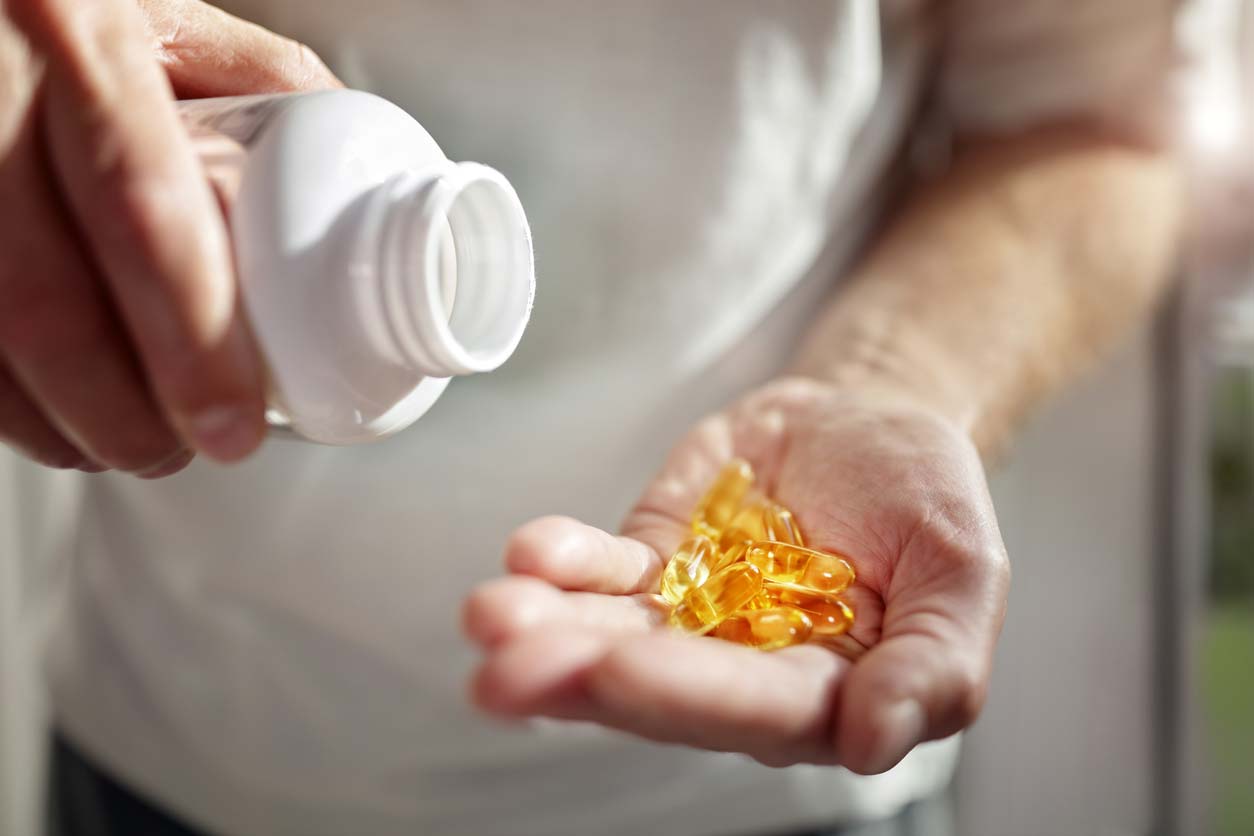Ella Fitzgerald and Frank Sinatra agreed that “Life is sweet on the sunny side of the street.” Other singers have advised us to “Keep to the sunny side of life.” And The Beatles reminded us that “It’s all right,” because “Here comes the sun.”
We instinctively feel better on sunny days. And despite fears of melanoma, the fact is that being out in the sun, in moderation, is good for you. One of the coolest tricks your body can pull off is done by your skin, which converts sunlight into a hormone essential for human health. The hormone in question, known as calcitriol, is incorrectly referred to as vitamin D. Incorrectly because the definition of a vitamin is an essential nutrient that cannot be synthesized by the body in sufficient quantities to maintain health. With that bit of nitpicking out of the way, I’m going to conform to the prevailing norms, and call it vitamin D for the rest of this article.
Vitamin D, also known, for obvious reasons, as “the sunshine vitamin,” has a number of health benefits, most famously when it comes to your bone health. And it has come into the spotlight recently, in the context of COVID-19, as a potential immunity booster. (More about that later.)
But even though the evidence is clear that having enough vitamin D is critically important, 61% of the elderly population in the United States (and 96% in India) have some degree of vitamin D deficiency. Checking for vitamin D deficiency isn’t usually a part of standard blood tests in every physician’s office, so it’s often missed. And if you are deficient, you might not know it.
So what exactly is vitamin D? How much do you need? And do you need to supplement it?
What Is Vitamin D?

Vitamin D is called calcitriol, or sometimes cholecalciferol (vitamin D3), because it is calciferous (“carrying calcium around”) and a sterol (a type of steroid hormone).
Vitamin D is primarily obtained from your body’s response to the sun’s UV rays when they penetrate your skin. In addition to direct sun exposure, you can also get vitamin D from a few foods, as well as dietary supplements. It’s a fat-soluble vitamin, which means that if you take it orally, you’ll need to accompany it with at least some fat for the best absorption. Furthermore, while water-soluble vitamins are excreted and not stored in the body, vitamin D and other fat-soluble vitamins (like A, E, and K) accumulate in fatty tissues throughout your body.
Vitamin D promotes calcium absorption in your gut and helps your body to maintain adequate serum calcium and phosphate concentrations. Vitamin D also works together with vitamin K to regulate calcium metabolism, which is essential for heart health. And it also plays a key role in skeletal health and bone strength. Plus, it controls the reduction of inflammation, as well as modulation of processes like cell growth, neuromuscular and immune function, and glucose metabolism.
7 Health Benefits of Optimal Vitamin D

Your body needs vitamin D — and enough of it — to run properly. In fact, vitamin D offers a number of health benefits both on its own and through working together with other compounds in the body. Here are seven great reasons to “Let the sunshine in” on a regular basis.
1. It’s good for your muscles and bones.
You need vitamin D in order to absorb calcium, which is necessary to grow and maintain strong bones. Research shows that when people are vitamin D deficient, they have worsened skeletal integrity. For example, in a 2017 study published in Nutrients, researchers found that supplementation of vitamin D2 over the course of six months reduced oxidative protein damage, decreased self-reported pain, improved quality of life, and improved grip strength and physical performance in osteoarthritis patients. Let’s recap: less damage, less pain, stronger, and happier. Sounds good to me!
In addition to bone health, vitamin D is also needed for the normal development and growth of muscle fibers — the thousands of muscle cells that are tightly wrapped together to form your muscles. As such, having inadequate levels of vitamin D in the body can lead to muscle weakness and pain.
2. It might have protective effects against cancer.
Research has shown that having higher serum levels of vitamin D is associated with a lower cancer incidence. In fact, a 2019 meta-analysis of prospective cohort studies published in Nutrients looked at 16 studies involving 101,794 participants to determine the relationship between serum vitamin D levels and risk of cancer diagnosis and mortality. The researchers concluded that with each 20 nmol/L (that’s pronounced “nanomoles per liter,” in case you’re reading this article out loud as a bedtime story) increment increase of 25-hydroxyvitamin D (another name for calcidiol) concentration, the risk of developing cancer dropped by seven percent.
This relationship remains when looking at specific types of cancer, too. Another 2019 study found that higher serum vitamin D levels were associated with statistically significant, substantially lower risk of colorectal cancer among women. While not as significant, the same association was also seen among men. And in a 2020 review, researchers concluded that epidemiological evidence suggests there is a link between higher vitamin D levels and a lower risk for ovarian cancer as well.
3. It offers cardiovascular benefits.
Another health benefit of having adequate vitamin D levels in your body is heart health protection. A 2017 meta-analysis of 32 studies published in the American Journal of Clinical Nutrition found that higher serum vitamin D levels were inversely associated with total cardiovascular disease events, like heart attacks and strokes, and, ultimately, mortality from them.
A 2018 review and meta-analysis published in Nutrients also examined the relationship between vitamin D levels and ischemic stroke risk. The authors found that having lower vitamin D status was associated with a higher risk for ischemic stroke.
4. It may be protective against autoimmune diseases.
An autoimmune disease is a condition in which your immune system mistakenly attacks your body. A 2017 study published in Neurology found that vitamin D deficiency is a risk factor for multiple sclerosis, a physically and mentally progressive autoimmune disease in which the insulating covers of nerve cells in the brain and spinal cord are damaged. In a broader review from 2018, researchers concluded that vitamin D deficiency is prevalent in a number of autoimmune diseases. As such, vitamin D supplementation has been linked to the prevention of autoimmune diseases.
5. It may help prevent and manage type 2 diabetes.
Having adequate vitamin D levels appears to be helpful in the management of type 2 diabetes as well. In a 2018 review published in Nutrients, researchers found that when serum vitamin D levels among people with type 2 diabetes were increased, their insulin resistance was reduced.
In another 2018 meta-analysis, researchers found that low vitamin D levels were associated with an increased risk for hyperglycemia — or uncontrolled high blood sugar — in both people who did and did not have diabetes.
Learn what the latest scientific research says about how to prevent and reverse type 2 diabetes — using food and free lifestyle tips.
Join the FREE

Watch Here
6. It may protect your body against viral infections.
Vitamin D has recently been highlighted as a key player in the strength of our immune systems, especially when it comes to fighting off viral infections.
In a 2020 study, researchers examined the mean vitamin D levels among populations from 20 European countries as well as the documented cases of COVID-19 and the subsequent mortality rates from the virus. They found a potential correlation between lower vitamin D levels and higher incidence of COVID-19 risk and mortality.
An additional Spanish study on COVID-19 outcomes used vitamin D to treat patients already hospitalized for the disease. A total of 76 patients in the study were given the immunosuppressant hydroxychloroquine and the antibiotic azithromycin. Fifty of them were also given oral calcifediol (a vitamin D3 analog) daily, while 26 were not.
Of the 50 patients treated with calcifediol, only one required admission to the ICU (2%), while of 26 untreated patients, 13 required ICU admission (50%), and two died (8%). Although this was a small sampling of participants, the results were statistically significant when it came to reducing the severity of the disease.
These studies suggest that both screening for vitamin D deficiency and possibly using it as a supplementary treatment could play an important role in pandemic-related public health.
Other studies tell us that addressing vitamin D deficiency could also help protect against other viral illnesses, like seasonal influenza.
7. It may help prevent or treat depression and anxiety.
Vitamin D deficiency, or low vitamin D status, has been linked to depression and other mood disorders. Various parts of the brain, including the hippocampus (an alteration which has been linked to depression), have vitamin D receptors in neurons and glial cells (which are important parts of the nervous system).
One 2017 study on women with depression, anxiety, and type 2 diabetes found that there was a significant increase in mental health status after vitamin D supplementation. The women all had vitamin D levels below the recommended amount of 32 ng/ml and were given 50,000 IU of vitamin D2 once a week for six months. In some cases, perceived depression was halved from the beginning to the end of the study.
A 2020 review of 61 articles on vitamin D and depression also concluded that there is a biological link between the two. The review attributed this connection to ways in which vitamin D works with the body’s biological functions, especially the immune system and brain. And the best improvements are seen in clinical cases of depression where multiple symptoms are present.
Vitamin D Deficiency

Vitamin D deficiency — or not having enough vitamin D circulating in your blood — is a very common condition. Subclinical vitamin D deficiency is widely prevalent in almost every nation, impacting up to a billion people worldwide.
With chronic and/or severe vitamin D deficiency, a decline in intestinal absorption of calcium and phosphorus leads to hypocalcemia or a deficiency of calcium in the blood. Inadequate calcium can lead to secondary hyperparathyroidism, a condition in which your parathyroid glands make too much parathyroid hormone. This can result in accelerated bone demineralization, which can eventually turn into osteomalacia (softened bones) and osteoporosis (porous bones) in adults as well as rickets (softened and weakened bones) in children. Whew — a lot of hard words there. If you’re still reading this, you deserve a medal!
Vitamin D deficiency is diagnosed when the amount of vitamin D circulating in your bloodstream is lower than recommended levels for optimal health. So what should your levels be? That’s where the controversy begins! And it turns out there are many credible researchers coming to very different conclusions.
Guidelines for Vitamin D Levels
In 2011, the widely respected Endocrine Society issued a report which concluded: “Based on all the evidence, at a minimum, we recommend vitamin D levels of 30 ng/mL, and because of the vagaries of some of the assays, to guarantee sufficiency, we recommend between 40 and 60 ng/mL for both children and adults.” (That one is pronounced “nanograms per milliliter.”)
However, writing for the New England Journal of Medicine in 2016, several leading epidemiologists and endocrinologists stated that in their opinion, we are over-screening for vitamin D deficiency and unnecessarily treating individuals who are actually fine. Based on their analysis, a more appropriate cutoff for vitamin D deficiency would be much lower — 12.5 ng/mL.
This leads to another question, which is maybe what we should have been asking all along. What is optimal? Apparently, most people can survive with blood levels as low as 12.5 ng/mL. But is that what’s best?
Here too, there is controversy. But a growing body of research is finding that the optimal blood levels of vitamin D are above 30 ng/mL, while other studies conclude that 40-60 ng/mL is the preferred range.
Can You Get Too Much Vitamin D?

The short answer is, yes. Remember that vitamin D is a fat-soluble vitamin, which means that it accumulates in your body and is stored over time — unlike water-soluble vitamins that are just peed away if you consume more than you need. So vitamin D can build up in your body, and side effects and toxicity are possible if your blood levels get too high.
Vitamin D helps your body absorb calcium from the food you eat. But too much of it can cause your body to store up excess calcium in your blood. Symptoms of hypercalcemia, or high blood calcium levels, include digestive distress, fatigue, and bone loss. And a 2019 study concluded that excessive use of vitamin D could cause kidney damage in people who are not deficient in the vitamin.
It’s important to clarify that excess vitamin D levels result from oral intake only; you can’t overdose on the vitamin D your body makes from sunlight. Your body is remarkably good at regulating how much naturally produced vitamin D is made and stored.
Vitamin D Toxicity?
Blood levels of 100 ng/mL are considered to be the upper limit of a normal or healthy range by the Institute of Medicine, the Endocrine Society, and many reference laboratories. But it turns out, it’s not easy to get your vitamin D levels that high. In one major study involving more than 17,000 healthy adult volunteers, vitamin D supplements as high as 20,000 international units (IU) per day didn’t get participant’s blood levels above 100 ng/mL and also didn’t lead to any evident toxic effects.
A 2015 study looked at data from more than 20,000 people over the course of 10 years. The researchers found that only 37 people had levels above 100 ng/ml.
However, while 100 ng/mL might be a rarely reached upper limit, there are studies that have shown a small level of increased mortality with blood levels of 50 ng/mL or higher. While the evidence is a bit murky, it does seem that vitamin D toxicity is rare, and that somewhere in the 30-60 ng/mL range could be the “sweet spot” for most people.
Getting Your Levels Checked
There are certain individual factors that can increase your risk of being vitamin D deficient. Some of these include:
- Not eating fatty fish (since they are the main source of dietary vitamin D);
- Being of advanced age;
- Having limited or inconsistent outdoor sun exposure;
- Having high melanin levels in your skin (generally, this accompanies dark skin pigmentation);
- Having medical conditions that can limit fat absorption;
- And being obese.
If you fall into any of these categories, checking your vitamin D levels is especially important.
Getting your vitamin D blood levels checked isn’t difficult. The test can be done with a pinprick of blood. This could give you very useful information. If you decide to take a significant dose of supplemental vitamin D (over 2,000 IUs per day), you may want to check your blood levels again after a few months of doing so to see if or how things have changed.
Studies have shown that each additional 100 IU of vitamin D3 you consume per day will raise your blood vitamin D levels by 1 ng/ml (2.5 nmol/l), on average.
There are also options to check your vitamin D at home, using a finger prick test. These can be easily obtained and done without a doctor’s prescription, such as the EverlyWell Vitamin D Test. Simply conduct the test in the comfort of your own home (which you will temporarily make marginally less comfortable by drawing blood from your fingertip), and ship it using the prepaid shipping label, where it will be evaluated in a test lab by a physician. Your results will be uploaded to a secure online platform within one to two weeks of receipt.
Where Can You Get Vitamin D?

There are three main places you can find vitamin D: sunshine, certain foods, and dietary supplements.
Sunshine
When your skin is exposed to sunlight, it manufactures vitamin D. The sun’s ultraviolet B (UVB) rays interact with a protein called 7-DHC in your skin, converting it into vitamin D3 — the active form of vitamin D. This is the best way to get vitamin D. Recommendations for time in the sun vary and depend on individual factors like skin pigmentation, age, the latitude of where you live (there is less direct sunlight further from the equator), skin cancer risk, and the season. But you don’t need to devote hours a day to sun-worship; recommendations range from 7-30 minutes per day over a large portion of your body. Studies have found that people with dark skin pigmentation may need up to sixfold more sun exposure than people with light skin to get the same vitamin D3 production in their skin.
Food
While there are some dietary sources of vitamin D, very few foods naturally contain it. Vitamin D is found in certain types of fatty fish (e.g., halibut, salmon, and mackerel), animal organ meats like liver, and in very small amounts in eggs and dairy products. Most foods containing vitamin D, including dairy milk, are fortified with it, meaning that the nutrient is added to them as a supplement. You can find vitamin D in fortified cereals, orange juice, and many plant-based milks, and it will be noted on the ingredients list.
The only plant-based foods that naturally contain vitamin D are some types of mushrooms, which contain it in the form of vitamin D2. Mushrooms produce vitamin D similarly to how humans do when our skin is exposed to sunlight. The vitamin D content of mushrooms can be increased either by exposing them to direct sunlight or using UV lamps during their growing process.
Supplements
The most reliable way to raise your vitamin D levels is to take it as a supplement. There are two main forms of vitamin D: vitamin D2 (ergocalciferol) and vitamin D3 (cholecalciferol). These two types of vitamin D are not equal when it comes to raising your serum vitamin D status. Both are effectively absorbed into the bloodstream, but your liver metabolizes them differently. Vitamin D3 appears to be much more effective in raising blood vitamin D levels than vitamin D2.
Vitamin D Supplements

Vitamin D can be found as a supplement on its own or as part of a multivitamin. It’s also added to a number of omega-3 fatty acid supplements.
Note that the American Academy of Pediatrics recommends all breastfed babies receive a daily dosage of 400 IU of vitamin D soon after birth to maintain their levels. This is because vitamin D is not transferred well through breastmilk. And babies generally shouldn’t be exposed to much sunlight. Formula-fed babies don’t typically need this supplementation because infant formula is fortified with the vitamin D they need.
Most supplements come in the form of vitamin D3, or cholecalciferol. However, most D3 supplements are not manufactured from vegan sources. Instead, many come from animal products such as lanolin, which is a greasy substance produced by sebaceous glands of sheep and found in their wool. Still, vegan vitamin D3 supplements are becoming increasingly widespread. These are usually made from lichen, an organism that arises from algae or cyanobacteria. Vegan vitamin D2 supplements are also available but not usually recommended because they’re not as reliable when it comes to raising serum vitamin D levels. Plus, vitamin D2 appears to be more prone to degradation over time.
Micellized Vitamin D
While many vitamin D supplements come in gel, oil, or capsule form, there are also liquid dropper options called micellized vitamin D3. Micellization of vitamin D3 appears to improve its solubility, absorption, and bioavailability. Which explains why a miscible form of vitamin D3 may actually be more effective in raising serum vitamin D levels than a fat-soluble version.
(I tried to understand what micellization means, but when the first definition I found online stated, “Micellization is a dynamic phenomenon in which n monomeric surfactant molecules S associate to form a micelle Sn,” I decided that I didn’t need to know that badly.)
A 2016 study published in the Journal of Pediatric Endocrinology and Metabolism examined the effects of either 60,000 IU of fat-soluble vitamin D3 per month with milk or 60,000 IU per month of water-miscible vitamin D3. The study lasted for six months, and included 180 healthy kids, ages 13-14 years old. They found that the miscible form resulted in a significantly greater increase of serum vitamin D levels among the study participants.
Vitamin D and Vitamin K2
Research also indicates that vitamin D3 is best absorbed when paired with the nutrient vitamin K2. High blood levels of vitamin D — a potential problem for anyone taking D3 supplementation — can lead to excessive calcium accumulation in the blood, contributing to calcification of the blood vessels. Vitamin K2 helps make sure that calcium is used in the bones instead of ending up in the arteries where it doesn’t belong.
Once the vitamin D has done the job of making sure the calcium you consume hits your bloodstream, the vitamin K activates a protein called osteocalcin. This protein makes sure that the calcium that’s in your bloodstream winds up where you want it to go — in your bones and teeth.
Bottom line: You don’t want to be deficient in vitamin K if you’re taking vitamin D. For this reason, many people take their vitamin D and K together. (For our article all about the benefits of vitamin K for your health, and how much you may need, click here.)
If you’re looking for a vegan supplement that contains vitamin D3 and vitamin K2, here are a few options. (If you make a purchase using any of these links, the seller will also make a contribution to support FRN’s work.)
Complement makes an “all in one” vegan supplement that provides all nine specific nutrients that can be difficult to obtain even on a whole foods, plant-based diet — D3, K2, B12, DHA, EPA, Iodine, Zinc, Magnesium, and Selenium. Find out more here.
Purality Health makes a miscible vitamin D3 that’s combined with what they believe is the best form of K2, called MK-7. Find out more about this premium product here.
Sports Research makes an affordable vitamin D3 (5,000 IUs) plus the MK-7 form of K2 (100 mcg). Find out more here.
Get Your Sunshine Vitamin

Vitamin D is an essential fat-soluble vitamin that has a number of health benefits, including contributing to optimal bone health and a strong immune defense. Your skin makes it in response to sun exposure. And there are a relatively small amount of foods that have it. However, a billion people may still be deficient in it. And unless you spend lots of time in the sunshine, you may be as well, so supplementation is often recommended. But because it’s possible to get too much vitamin D, a blood test is also advisable to help you ensure you are in a healthy range.
As in all things: Use your own best judgment. And where appropriate, consult with a qualified healthcare professional about your specific health needs.
Tell us in the comments:
- Do you spend time in the sun?
- Have you ever been tested for vitamin D deficiency?
- What are some individual factors that may influence your vitamin D levels?
Feature image: iStock.com/Helin Loik-Tomson
Read Next:



